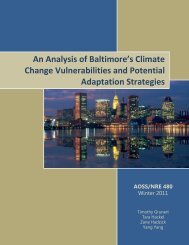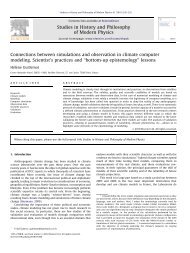Lal, Carbon Sequestration, PhilTransRoySoc 2008
Lal, Carbon Sequestration, PhilTransRoySoc 2008
Lal, Carbon Sequestration, PhilTransRoySoc 2008
Create successful ePaper yourself
Turn your PDF publications into a flip-book with our unique Google optimized e-Paper software.
Downloaded from rstb.royalsocietypublishing.org on April 14, 2010<strong>Carbon</strong> sequestration R. <strong>Lal</strong> 819exceeding the estimated fossil fuel reserves (Herzoget al. 1997, 2002). However, CO 2 injection may alsohave some adverse effects on deep sea biota (Auerbachet al. 1997; Caulfield et al. 1997; Seibel & Walsh 2001).In addition to the economics, the issue of stability ofsuch an injection must be addressed owing to theincreased stratification of the ocean water column andits turn over through natural processes.(ii) Geological injectionThis involves capture, liquefaction, transport andinjection of industrial CO 2 into deep geological strata.The CO 2 may be injected in coal seams, old oil wells (toincrease yield), stable rock strata or saline aquifers(Tsang et al. 2002; Klara et al. 2003; Baines & Worden2004; Gale 2004). Saline aquifers are undergroundstrata of very porous sediments filled with brackish(saline) water. In general, saline aquifers are locatedbelow the freshwater reservoirs with an impermeablelayer in between. Industrial CO 2 can be pumped intothe aquifer, where it is sequestered hydrodynamicallyand by reacting with other dissolved salts to formcarbonates. <strong>Carbon</strong> dioxide is injected in a supercriticalstate that has much lower density and viscosity than theliquid brine that it displaces. In situ, it forms a gas-likephase and also dissolves in the aqueous phase, creatinga multiphase multicomponent environment. InjectingCO 2 into reservoirs in which it displaces oil or gas couldbe an economic strategy of enhanced oil recovery(EOR). Production from oil and gas fields, which hasbeen in decline, is raised by CO 2 -enhanced recovery(Klusman 2003). This strategy of CO 2 sequestration isused in Texas, USA, to inject 20 million Mg ofCO 2 yr K1 at a price of $10–$15 Mg K1 (Lackner2003). The technique is also used in offshore oil wellsin Norway. In a strict sense, however, this is notsequestration when the CO 2 injected is extracted fromunderground wells. The CO 2 can also be injected intounmineable coal seams where CH 4 is absorbed.Injected CO 2 is absorbed onto coal twice as much asCH 4 , and the process enhances the gas recovery of coalbed CH 4 (CBM). Principal concerns about geologicalsequestration, similar to that of the oceanic, are(Kintisch 2007a; Schrag 2007): (i) reliability of storageof vast quantities of CO 2 in geological strata and (ii) thecost. Some have argued that risks of leakage are low.However, to date, a few direct injection of CO 2 havebeen made on a commercial scale although theRegional <strong>Carbon</strong> <strong>Sequestration</strong> Partnership project ofUS DOE is planning for several demonstrations during<strong>2008</strong>–2009. Similar to oceanic injection, cost andleakage are principal issues of geological sequestrationwhich need to be resolved. Owing to the low densityand viscosity and injection under supercritical conditions,the risks of CO 2 leakage through confiningstrata may be higher than currently injected liquidwastes (Tsang et al. 2002). In addition, the chemicalinteractions of CO 2 with the geological formations mayhave to be considered in formulating guidelines forappropriate regulatory and monitoring controls.(iii) Scrubbing and mineral carbonationMineral carbonation is achieved through mimicry ofnatural inorganic chemical transformation of CO 2(Fan & Park 2004). It involves transformation ofindustrial strength CO 2 emissions into CaCO 3 ,MgCO 3 and other minerals in the form of geologicallyand thermodynamically stable mineral carbonates. It isa two-stage process: scrubbing and mineral carbonation.Scrubbing, the process of chemical absorption ofCO 2 using an amine or carbonate solvent, is the mostwidely used method of carbon capture. The CO 2 ispurified by passing through an absorption columncontaining amine solvent. Other solvents used areK 2 CO 3 , lithium silicate, ceramic and nickel-basedcompounds. Pure CO 2 gas, recovered by heating theCO 2 -rich amine, is re-precipitated through mineralcarbonation. <strong>Carbon</strong>ates thus formed are stable rock inwhich CO 2 is sequestered forever. Aqueous mineralcarbonation reactions leading to the formation ofmagnesite (MgCO 3 ), olivine (Mg 2 SiO 4 ) and serpentine(Mg 3 Si 2 O 5 (OH) 4 ) are as follows (Gerdemannet al. 2003):2 MgSiO 4 CCO 2 ðgÞ C2H 2 O/Mg 3 Si 2 O 5 ðOHÞ 4CMgCO 3 ð16:5 KCalÞ;Mg 2 SiO 4 C2CO 2 ðgÞ/2 MgCO 3CSiO 2 ð10:3 KCalÞ andCaSiO 3 CCO 2 /CaCO 3 CSiO 2 ð10:6 KCalÞ:All these reactions occur in nature and can bereplicated in industrial settings. The industrial processof mineral carbonation has been described by Lackneret al. (1996, 1997) and O’Connor et al. (2000). Theprocess uses a slurry of fine particle-sized mineral inwater, at solid concentrations of 15–30%. Dissolutionof the mineral and subsequent carbonation occur in asingle operation as per the following theorized reactions(O’Connor et al. 2000; Gerdemann et al. 2004):CO 2 CH 2 O/H 2 CO 3 /H C CHCO K 3;Mg 2 SiO 4 C4H C /2Mg C2 CH 4 SiO 4 or SiO 2C2H 2 OandMg C2 CHCO K 3 /MgCO 3 CH 2 :Geological studies have shown that reserves ofultramafic (ultrabasic) minerals are sufficient toprovide raw materials for mineral carbonation ofindustrial emissions for long time (Goff et al. 1997,2000). However, these are geological reactions andoccur at slow rate. The challenge lies in increasing therate of reaction by decreasing the particle size,increasing temperature and pressure and using catalyticagents (Fan & Park 2004). Increasing the rate ofreactions, however, requires energy and is expensive.(b) Biotic sequestrationBiotic sequestration is based on managed interventionof higher plants and micro-organisms in removing CO 2from the atmosphere. It differs from managementoptions which reduce emission or offset emission.Increasing use efficiency of resources (e.g. water,energy) is another option for managing the terrestrialC pool (table 1). Some biotic sequestration options arebriefly described below.Phil. Trans. R. Soc. B (<strong>2008</strong>)




